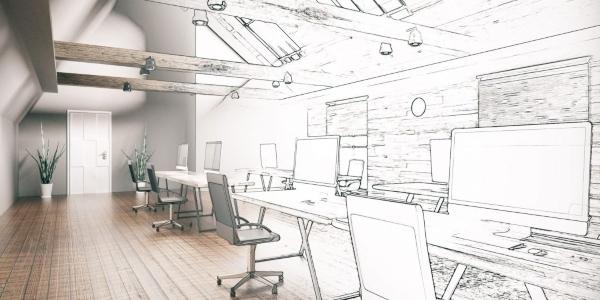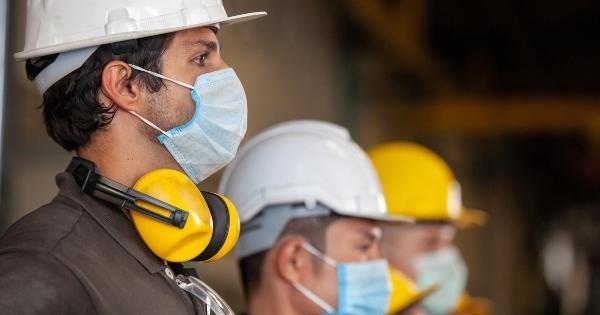3 Factors Impacting the Post-COVID Workspace

By Amanda Dodge, CertainTeed.
Understand what the future of interior office design looks like and how to prepare for it.
Many companies are doing their best to survive the current pandemic and economic uncertainty, while others are looking towards the future. As businesses begin to reopen across the country, it’s important to think about how COVID-19 will impact how we interact with each other in the office environment and how offices will be designed. Through changes in office layouts, business leaders are doing what they can to make their campuses more sanitary.
This means that COVID-19 will impact all aspects of work and the economy, even commercial construction. Consider these three factors that will impact your blueprint designs and client requests in the future.
Remote work will likely continue
Remote work has risen steadily over the past few decades. By 2019 estimates, the number of people who work from home has increased by 140% since 2005. The coronavirus could be the push that some employers need to authorize more remote work for their employees.
In April 2020, Gartner surveyed 317 CFOs on what the workplace will look like after the COVID-19 quarantine is lifted. It found that 74% of leaders plan to move at least five percent of their workforce to remote positions permanently. A quarter of respondents plan to move at least 20% of their workforce to permanent remote positions.
There are significant financial benefits for companies that allow remote work. In 2015, Citigroup moved to a “hot-desking” layout where employees worked where they wanted and didn’t have assigned desks. This move reportedly saved the company $10 million annually. When employees telecommute – even part-time – companies have to pay rent on empty space. Citigroup was able to rent a much smaller space while authorizing more remote work.
Within the commercial construction sphere, developers can expect offices to grow smaller as less cubicle space will be required since more employees will work remotely. Still, demand for conference rooms and meeting space may increase when these remote employees come into the office.
Employees will have more space to work
While some companies may want less room because of their increasingly remote workforce, others may need more space to prevent the spread of germs.
WeWork is a company that offers hot-desking, co-working, and affordable office space for entrepreneurs and startups. It recently announced its planned changes to prevent the spread of illness after the pandemic has passed. These include slashing meeting space capacity in certain rooms so attendees will be more spread out, and creating “buffer zones” where tenants can work more than six feet apart.
“While we don’t know for certain the long-term impact COVID-19 will have, there is no doubt that our reentry back to the workplace will require a greater emphasis on professional distancing,” WeWork CEO Sandeep Mathrani said in an email to clients.
This professional distancing means giving employees more space, and building offices and cubicles (instead of an open floor plan) that can limit the spread of bacteria and viruses through the workplace.
COVID-19 will change the focus of interior office design
Along with changing the physical size and layout of office buildings, the coronavirus pandemic will impact how companies want their offices to be designed. As a result, commercial developers will need to be at the forefront of office tech, flooring and materials in order to install exactly what customers want and find useful.
For example, touchless technology is highly in-demand. This is evident on the consumer-facing side with brands like Publix speeding up plans to launch contactless payment or tap-to-pay systems. Similar trends will follow in office buildings, with technology for swiping IDs, clocking in and out, and generally navigating the office environment quickly getting installed. It is entirely possible that buyers will expect this technology to come standard with a workspace, or at least have the infrastructure built in to install it.
Additionally, demand for design materials like antimicrobial carpet and flooring will likely increase dramatically. Companies want materials that can break down particles that threaten the health of human workers, including bacteria and fungi. They also want surfaces that can be easily cleaned and sanitized should there be another coronavirus flare-up or future pandemic.
American workers can expect to see both small and large changes to their work environments once this pandemic passes. Along with major changes like increased remote work and smaller office spaces, there will be minor adjustments like contactless ID scanners. Commercial developers need to be aware of these expectations and develop workspaces to meet their clients’ needs.
Learn more about CertainTeed in their RCS Directory.
Original article source: CertainTeed
About CertainTeed
Through the responsible development of innovative and sustainable building products, CertainTeed, headquartered in Malvern, Pennsylvania, has helped shape the building products industry for more than 110 years. Founded in 1904 as General Roofing Manufacturing Company, the firm's slogan "Quality Made Certain, Satisfaction Guaranteed," inspired the name CertainTeed. Today, CertainTeed is a leading North American brand of exterior and interior building products, including roofing, siding, solar, fence, decking, railing, trim, insulation, drywall and ceilings.
A subsidiary of Saint-Gobain, one of the world’s largest and oldest building products companies, CertainTeed has more than 6,900 employees and more than 60 manufacturing facilities throughout the United States and Canada. The group had total sales of approximately $3.9 billion in 2018. www.certainteed.com.




















Comments
Leave a Reply
Have an account? Login to leave a comment!
Sign In